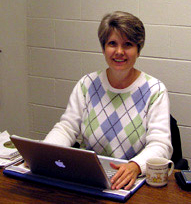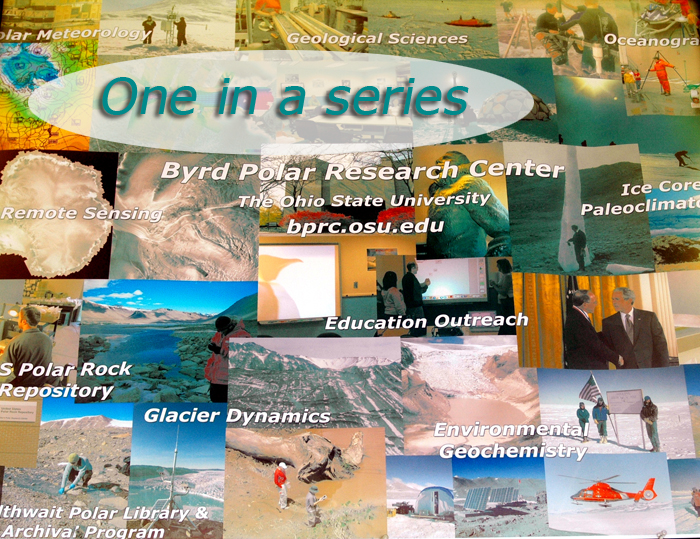|
Public educationOutreach program fosters awareness about work conducted by Byrd scientistsPosted June 20, 2008
Carol Landis retired from teaching five years early — and went right to work educating the public about what scientists are doing at Ohio State University’s Byrd Polar Research Center (BPRC). “I’ve been an Earth Science and environmental groupie for a long time,” says Landis while sitting in BPRC’s Learning Center, a classroom outfitted for high-tech education and presentations. A retired high school science teacher, Landis helped start BPRC’s education and outreach program about three years ago. “I felt very strongly that there’s a lot of really good science going on here but it’s not [generally accessible to the public],” she explains. “[Byrd Polar scientists] do their outreach like their supposed to … but it tends to be more conference presentations, support of graduate students, and public presentations here or there that are hard-core science. “And the public doesn’t get it. I really feel strongly that we need to make a better bridge to the public … Hopefully, public opinion will begin to make a difference [with climate change]. For that to happen, we need to get the information out in a manner that they can understand.” About 75 people are involved with the research center in one capacity or another (See related story: At the forefront.) It includes eight research groups: polar meteorology, ice core paleoclimatology, oceanography, glacier dynamics, geology, the polar rock repository, environmental geochemistry and remote sensing. Many of the center’s investigators are involved in climate change science, which Landis works to convey through the public outreach program. “That’s the theme that binds everybody together,” she says. “They’re all contributing in one form or another to climate change research, some on a more basic level than others.” 
Carol Landis
Landis conducts two tours per month for schools, taking students to labs and tailoring the presentations to what they are studying in class. A favorite stop is usually the U.S. Polar Rock Repository She also takes outreach out of the OSU campus, from attending Earth Day events to making presentations to church groups. Graduate students and professors also make visits to schools in the community. “She’s made a big impact,” says Mike Willis, a postdoctoral fellow at BPRC. “We’re getting better education and outreach.” He notes that many undergraduate students at OSU don’t know that Byrd Polar exists on campus, let alone that it is one of the premiere institutes of its kind in the nation. “That’s wrong,” he says. “We shouldn’t just have a national presence, but a strong local presence as well.” Toward that goal, BPRC converted a dusty, unused laboratory into a multimedia learning center. Part of the support for the center came from the National Science Foundation’s Science and Technology Center for the Remote Sensing of Ice Sheets (CReSIS), by providing funding for a graduate research associate to work at the learning center. Forget about the blackboards of yesteryear. The learning center has two, touch-screen SMART Boards™. The touch-sensitive display connects to a computer and digital projector to show a computer image. A user can then control computer applications directly from the display, write notes in digital ink and save work to share later. The room is also used to host a variety of groups, from members of the American Chemical Society to ministers from the Saudi Arabian Ministry of Education. “It just depends on who wants to be here and what our schedules are like,” Landis says. “It’s kind of crazy.” Many BPRC faculty members pay more than lip service to education and outreach. Terry Wilson, a professor in the School of Earth Sciences, hopes to have four minority interns work with her team this summer. She is collaborating with organizations like UNAVCO “I’m pretty excited about that,” she says. “Even though it seems like a drop in the bucket, I’m hopeful that the approach that we’re building on … will not only get us some new blood in the Antarctic sciences, but some more diverse blood.” Willis says that, according to UNAVCO, of the 21,000 PhDs in Earth sciences since the 1970s, only about 200 are African-American. “That’s bad,” he says. “That’s something that needs to be fixed.” While OSU professors like Wilson are interested in recruiting more people into the sciences, Landis remains committed to swaying people to take issues like climate change more seriously. While she believes people are awakening to the challenges, she remains pragmatic. “We have the luxury of sitting here and thinking about environmental conditions 30 or 40 years from now. A lot of countries are just sitting there and wondering if they can just get through this year. But that, to me, makes it even more imperative for us to do something.”
|



For USAP Participants |
For The Public |
For Researchers and EducatorsContact UsU.S. National Science FoundationOffice of Polar Programs Geosciences Directorate 2415 Eisenhower Avenue, Suite W7100 Alexandria, VA 22314 Sign up for the NSF Office of Polar Programs newsletter and events. Feedback Form |



